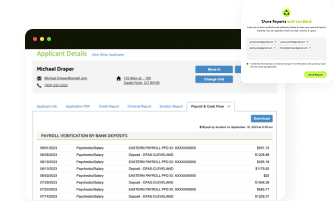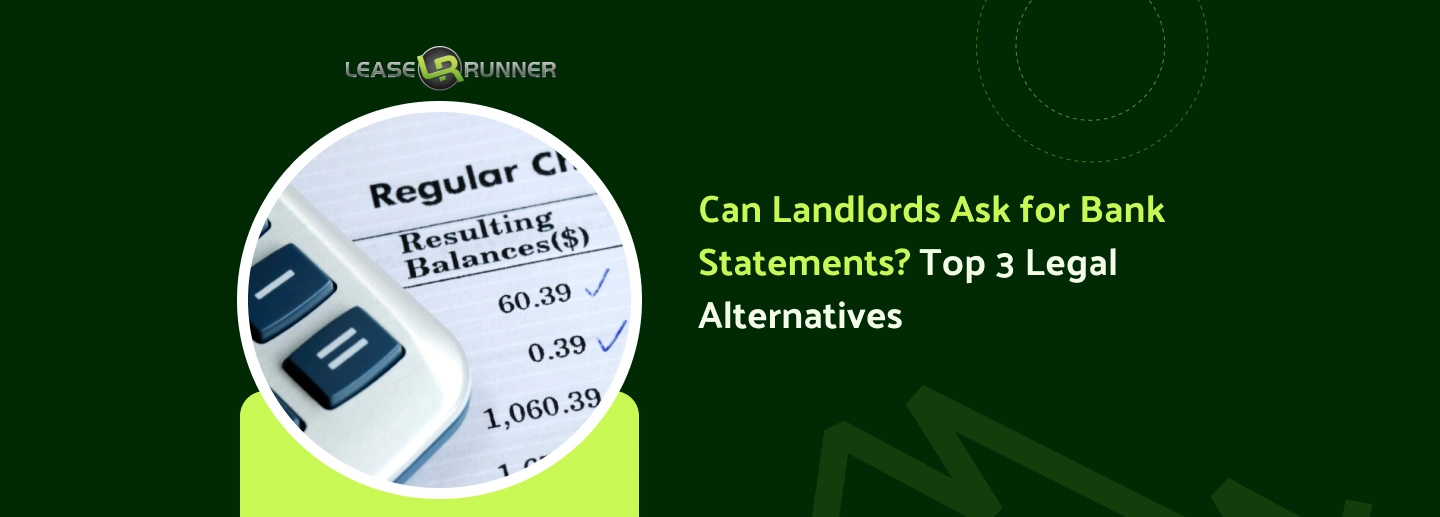Understanding the difference between a credit score vs credit report is key for landlords. A credit score is a three-digit number that shows a tenant's credit risk. A credit report gives a full history of their credit use. Landlords use credit scores for a quick view of risk.
They check credit reports to find details like late payments or bankruptcies. For example, a tenant might have a good credit score but a recent bankruptcy on their credit report. Knowing what credit scores and reports are and how credit scoring models like FICO and Vantage Score work helps landlords make smart choices.
This guide covers the difference between a credit report and a score, explains what a credit profile is, and shows the best way to check a credit score. With this, landlords can screen tenants well and protect their investments.

Key Takeaway: Quick Facts About Credit Score vs Credit Report
What Is a Credit Score?
A credit score is a three-digit number, usually between 300 and 850, that summarizes a person’s credit risk. It is based on information in the person’s credit report and shows how likely they are to repay debts on time. For landlords, a higher credit score usually means a tenant is more likely to pay rent consistently and on time. For example, a tenant with a score above 700 is often seen as low risk, while a score below 600 might raise concerns.
Credit scores are often used by landlords to rapidly assess a tenant's financial stability. The definition of a credit score, its calculation, and the risk variables that might influence it are all covered in this section. Landlords may make better tenant screening selections by being aware of this information.

Credit Score vs Credit Report: Key Differences for Landlords
Understanding the distinctions between credit scores and credit reports enables landlords to make informed decisions about potential renters. This knowledge enables a well-rounded strategy that makes use of both rapid evaluations and in-depth insights.

Landlords often face one major challenge: how to choose the right tenant. Renters come with different financial habits, and those habits show up in two common tools: the credit score and the credit report. Together, they act like a lens into the renter’s past and present borrowing practices.
Knowing the difference helps landlords balance speed with depth when screening applicants. That is the core of the credit score vs credit report discussion.
What Are They?
A credit score and a credit report both explain a tenant’s borrowing and repayment habits, but they do so in different ways.
- The credit score is a three-digit number created by scoring models such as FICO Score or VantageScore. The range usually falls between 300 and 850. A higher figure suggests stronger creditworthiness. This number comes from many factors, like payment history, total amount owed, credit utilisation, length of credit history, recent credit activity, and credit mix.
- The credit report is a comprehensive document that details the applicant’s credit accounts, account history, inquiries, bankruptcies, liens, borrowing and repayment history, and on-time payments. It is issued by the major credit bureaus—Experian, Equifax, and TransUnion.
In simple terms, the credit score works as a numerical representation of risk, while the credit report works as a credit story explaining how that number comes to be. When discussing credit score vs credit report, one may imagine a quick snapshot compared to a full photograph.
Purpose for Landlords
Landlords use the credit score and credit report in different ways. Each tool has value, but they work best together.
- The credit score is fast. It gives a quick way to judge risk. A landlord looks at the number and sees if the tenant meets the standard. Many landlords set a score rule, like 620 or 650. That makes it easy to filter renters. Guides, such as what credit score is needed to rent an apartment, show how these cutoffs change with location and property demand.
- The credit report tells a longer story. It shows payment history, past bankruptcy, open credit accounts, and any recent inquiries. This detail goes beyond the number. Two tenants may both have a 650 score.
One earned it by recovering from collections. The other built it through many years of steady on-time payments. By viewing the credit score and report together, landlords see the full picture.
Level of Detail
The credit report and score differ in depth:
- A credit score condenses data from the report into one number. Influencing elements include:
- Payment history (most influential): Whether the tenant pays bills on time.
- Credit utilisation (highly influential): How much of the available credit is used.
- Total amount owed (moderately influential): The balance carried across accounts.
- Length of credit history: Average age of accounts.
- Credit mix: Use of revolving (credit cards) and installment loans.
- Recent credit activity, new inquiries, and new accounts (less influential).
- A credit report, on the other hand, covers names of creditors, borrowing and repayment history, details of liens, old closed accounts, and soft vs hard inquiries. For landlords using services like credit check screening tools, the report delivers that detailed view.
Thus, credit score versus credit report are very much about quick judgment compared with comprehensive depth.
What They Reveal
When landlords review a credit score:
- They see how scoring models like FICO weigh payment history, utilisation, and other factors.
- They quickly gauge risk in renting to an applicant.
When landlords review a credit report:
- They uncover past bankruptcies, liens, and patterns of missed payments.
- They spot if the tenant has applied for many loans recently (signals risk).
- They review the total available credit and whether the applicant has a balanced credit mix.
A landlord could notice an applicant with a strong numerical representation (say 720), but the credit report may show that most of that score comes from one single auto loan with perfect history, while credit cards are nearly maxed out. This subtlety only appears when both the score and the report are reviewed side by side, so credit score and report review together are key.
Potential Blind Spots
Both have blind spots.
- Credit score limitations:
- Lacks details on why the number dropped.
- Can hide red flags like past evictions or unpaid utilities.
- Varies depending on whether it comes from FICO or VantageScore. You can learn more about the VantageScore explanation to know more deeply how this range differs from FICO.
- Credit report limitations:
- Can contain errors. Since scores derive from reports, mistakes (like duplicate accounts), can lower a tenant’s score. Landlords need to understand that a tenant can only dispute the report, not the number itself. After correction, the score recalculation comes automatically.
- Heavy detail may overwhelm landlords who want speed.
These blind spots explain why many landlords need both tools in balance. Just relying on the credit score vs the credit report one way tilts the tenant evaluation toward either speed or depth, but not both.
Key Summary Table
This table shows why reviewing credit score and credit report together creates a sharper, balanced view.

Best Practices for Landlords When Reviewing Credit Information
Screening tenants is one of the most important steps in protecting rental property. A clear process gives landlords a consistent way to evaluate applicants and reduces the risk of problem leases. Both the credit score and credit report reveal valuable details, but using them well also means applying fair policies, following the law, and relying on trusted tools. The following best practices can help landlords gain a balanced view of each applicant.
1. Define and Apply Consistent Screening Criteria
Every landlord should set standards early. For example, one may choose not to rent to tenants with a score under 600. Another may allow those with lower scores but require a larger deposit. Writing these rules down ensures fairness.
Guidance from resident score vs credit score comparisons highlights why consistency matters when looking at credit score vs credit report, since different tools provide slightly different risk signals.
For example, a landlord managing three single-family homes requires a savings-to-rent ratio of 2:1 plus a minimum credit score. Each applicant is judged by those same standards, ensuring equal treatment.
2. Get Proper Consent and Use a Reliable Screening Service
A landlord must obtain written permission before accessing a tenant’s credit. Services like soft and hard credit check options describe the difference. A soft inquiry does not affect the applicant’s score, while a hard inquiry may lower it slightly.
Choosing a trusted tenant screening service, such as credit monitoring platforms designed for landlords, ensures reliable data. This prevents landlords from falling victim to identity protection scams or outdated reporting.
3. Look Beyond the Credit Score
Many landlords stop at the number. That practice can result in poor tenant matches. Instead, check for payment history details on the credit report, especially any records of on-time vs late payments.
For instance, one applicant has a 720 score, but also three recent late payments listed on their account history. Another applicant shows a 650 score but a clean record of consistent on-time payments with modest balances. A deeper look at the credit report and score together may push a landlord to pick the latter.
4. Verify Additional Information
Screening goes beyond the credit score and credit report. A landlord should confirm employment and income using pay stubs or bank records. Resources like how to verify tenant income through documents give strong step-by-step advice.
In some cases, a landlord may ask for bank records if permitted. Details on whether landlords can ask for bank statements explain the limits of this request. Verifying income reduces reliance on credit score versus credit report analysis alone.
5. Handle Low Credit Scores Appropriately
Not every applicant with weak credit should be rejected. Instead, balance risk with protective measures. Landlords sometimes require:
- A higher security deposit.
- A qualified co-signer.
- Proof of steady employment.
Advice from guides on passing a rental credit check shows renters use these same strategies. Applying them as landlords can secure tenants who may recover well from past mistakes.
6. Comply with Legal Requirements
Fair housing rules forbid discrimination beyond lawful limits. If landlords base rejection on reports, they must provide adverse action notices. Under the Fair Credit Reporting Act, tenants also have the right to one free credit report annually, via AnnualCreditReport.com—and weekly free reports during certain periods.
Similarly, tenants should never be penalised for breaking a lease unfairly in credit terms unless landlords correctly report the debt. Guidance on reporting bad tenants to credit bureaus emphasises accuracy.
By following compliance steps, landlords protect both their property and their legal standing.
Extra Notes:
For landlords, judging between a credit score and a credit report is not an either-or choice. The credit score delivers fast screening through a three-digit number, while the credit report offers a comprehensive document packed with context.
Each has blind spots, but together they produce a sharp picture of rental risk. By following best practices (defining criteria, seeking consent, confirming income, and going beyond numbers), landlords safeguard against vacancy loss and problem tenants while ensuring fairness in their process.

How to Use LeaseRunner to Check Credit Score & Credit Report?
LeaseRunner simplifies tenant screening by providing landlords with easy access to both credit scores and reports. Here’s how landlords can use it step-by-step:
- Step 1: Create an account on LeaseRunner.
- Step 2: Request tenant authorisation to pull credit information.
- Step 3: Access up-to-date credit scores and detailed credit reports in one dashboard.
- Step 4: Review scores for quick risk assessment and dig into reports for red flags like late payments or bankruptcies.
- Step 5: Use LeaseRunner’s rent collection tools to automate reminders and reduce late payments.
- Step 6: Make informed leasing decisions based on comprehensive credit data.
Using LeaseRunner helps landlords save time, reduce errors, and avoid costly tenant screening mistakes.
Conclusion
Landlords who grasp the difference between credit score vs credit report can make better tenant decisions. Credit scores provide a quick risk overview, while credit reports offer detailed financial history, revealing issues like collections or judgments.
LeaseRunner can simplify access to this data in a single comprehensive credit report, including VantageScore and legal records. Understanding models such as FICO score vs Vantage Score helps interpret results accurately. Combining these resources allows landlords to reduce risks, avoid errors, and secure reliable tenants, protecting their investments effectively.
FAQs
Q1. Is a credit report the same as a credit score?
No, they are related but different. The credit report provides the full credit history, and the credit score is a number derived from that history.
Q2. What is a credit profile?
A credit profile includes your credit reports and credit scores combined. It reflects your overall credit health and is used by lenders and landlords to evaluate your financial reliability.
Q3. What is the best way to check a credit score?
Use trusted services like LeaseRunner or official credit bureaus (Equifax, Experian, TransUnion). Many banks and credit card companies also offer free credit score access.
Q4. Is there only one type of credit report?
No, there are three major credit bureaus, each producing its own credit report. These reports may vary slightly as they receive different data from creditors.
Q5. What is the difference between the FICO score and the Vantage Score?
Both are credit scoring models, but they use slightly different formulas. The FICO score is most widely used by lenders, while the Vantage Score is an alternative developed by the three credit bureaus. Scores may differ slightly depending on the model.







